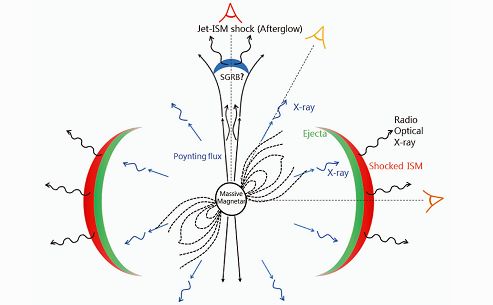The next generation gravitational-wave (GW) detectors are expected to detect GW signals from mergers of two compact objects. Due to the faint nature of GWs, an associated electromagnetic (EM) emission signal in coincidence with a GWB in both trigger time and direction would increase the signal-to-noise ratio of the GW signal, and therefore would be essential for its identification. We recently predict a bright broad-band EM counterpart for NS-NS merger scenario.

By with WU Xuefeng
A physical picture for several EM emission components appearing after the merger. A massive millisecond magnetar is formed at the central engine. Near the spin axis, there might be a SGRB jet. An observer towards this jet (red observer) would see a SGRB. At larger angles (yellow observer), a free magnetar wind may be released, whose dissipation would power a bright X-ray afterglow. At even larger angles (orange observer), the magnetar wind is confined by the ejecta (green shell). The interaction between the magnetar wind and ejecta would trigger magnetic dissipation of the wind and also power a bright X-ray afterglow. After releasing some dissipated energy, a significant fraction of the spinning energy would push the ejecta and shock into the ambient medium. Synchrotron emission from the shocked medium (red shell) would power brighter X-ray, optical and radio afterglow emission, which is calculated in this work.
Numerical simulations show that besides central merger product, binary neutron star coalescence process could also eject a small fraction of the materials, leaving behind a mildly anisotropic outflow with a typical velocity about 0.1 – 0.3 c. We proposed that when the equation of state of nuclear matter is stiff, a stable massive neutron star would form after the merger, if so, the proto-magnetar would eject a near-isotropic Poynting-flux-dominated outflow, which would push the ejecta to mildly or even highly relativistic speed, making a strong external shock upon interaction with the ambient medium to give rise to strong broad band afterglow emission. In some cases, the R-band magnitude can reach 11th at the 300 Mpc, if ejecta mass is small enough (so that the blastwave has a high Lorentz factor) and the medium density is not too low. The duration of detectable optical emission ranges from thousands of seconds to year time scale. The radio afterglow can reach the Jy level for an extended period of time, with peak reached in the year time scale. These signals can be readily picked up by all-sky optical monitors, and radio surveys. The X-ray afterglow can be also picked up by large field-of-view imaging telescopes such as ISS-Lobster. Besides confirming the astrophysical origin of GWBs, a combination of GWB and afterglow information would shed light into the detailed merger physics, and in particular, provide a probe of massive millisecond magnetars and stiff equations of state for neutron matter.
The work by H. Gao, X. Ding, X.-F.Wu (corresponding author), B. Zhang, & Z. G. Dai has been accepted to be published in the ApJ, please see ApJ, 771, 86 for more details (http://iopscience.iop.org/0004-637X/771/2/86/).
